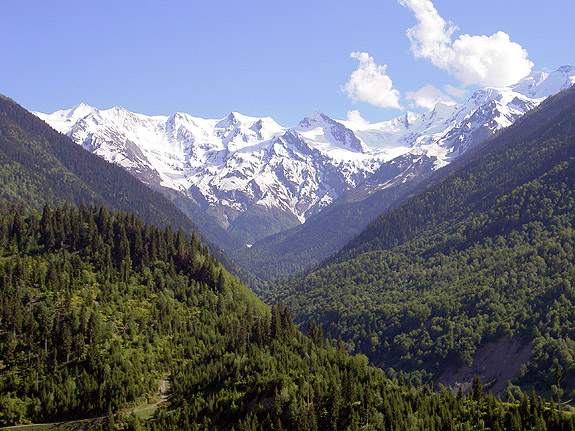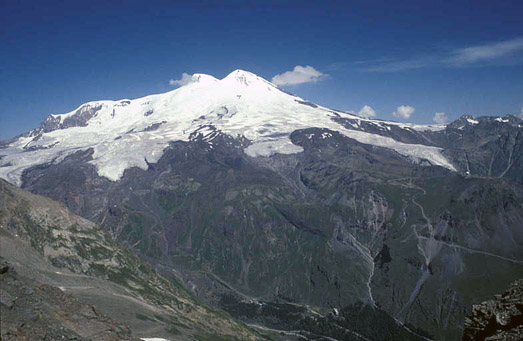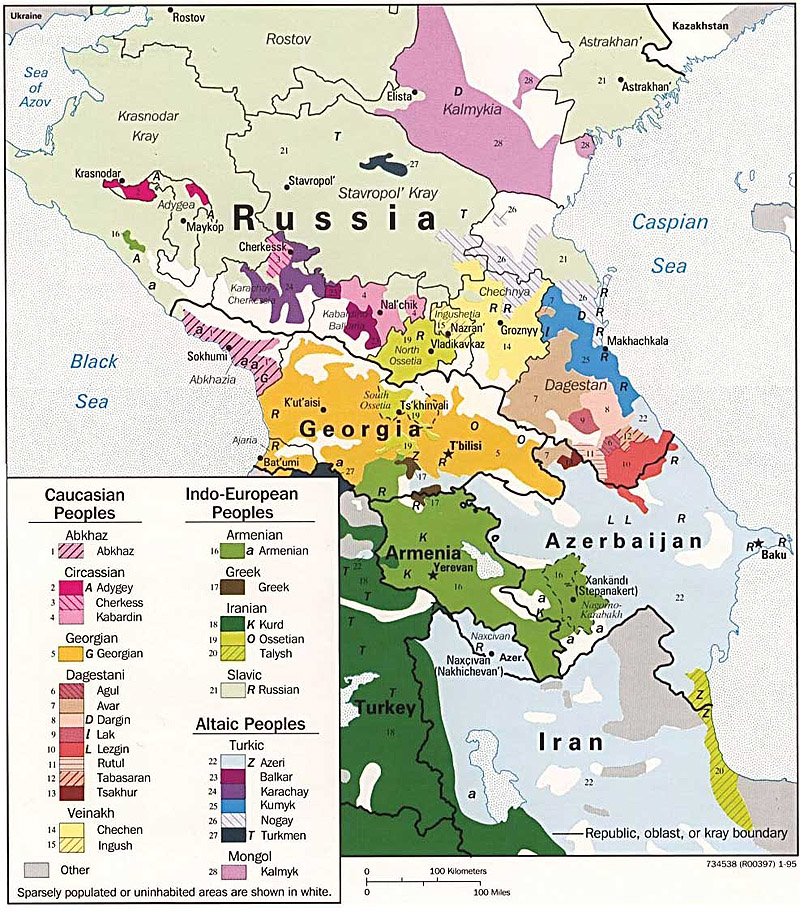
Caucasus Mountains in Georgia
The Caucasus Mountains (like the Ural Mountains to the northeast) are usually considered the dividing line between Asia and Europe, with the northern region of the Caucasus in Europe; and the southern (Trans-Caucasus) in Asia--so technically you can consider the mountains themselves as either part of Asia or part of Europe. The region is divided between Russia, Turkey, Iran, Georgia, Armenia and Azerbaijan, and bounded on the west by the Black Sea and on the east by the Caspian Sea. Three territories in the region claim independence but are not generally recognized: Abkhazia, Nagorno-Karabakh and South Ossetia (See below).
The mountains formed over twenty million years when the Arabian tectonic plate collided with the Eurasian plate. I found it interesting that the Caucasus Mountains are technically considered to be a continuation of the Himalayas. The entire Caucasus region is prone to strong earthquakes. The highest peak is Mount Elbrus (18,510 ft.) which is considered the highest point in Europe.
The climate of the Caucasus varies according to elevation and latitude location. For example, average temperature decreases as elevation rises. The same thing with precipitation, which increases with elevation. There is also more precipitation, including snowfall, on the western slopes of the mountains from the influence of the Black Sea.

Mt. Elbrus, highest point in the Caucasus, is a long-dormant volcano.
![]()
Russians were aware of the Caucasus as early as the reign of Ivan IV in the sixteenth century, but only under Catherine the Great was a calculated move into the region made (under the Viceroy of the Caucasus, Grigorii Potemkin). Shortly thereafter, Georgia (predominantly Christian) requested protection from Muslims to the south, and it was annexed into the Russian Empire in 1801. Since Russia had to maintain communications across the Caucasus Mountains with Georgia, hostilities broke out between the Russians and the mountain peoples of the Caucasus. It took Russia into the 1860s to finally subdue resistance from the guerrillas.
In the last twenty years, there has been a renewed outbreak of hostilities in different regions of the Caucasus. Some background reasons for those hostilities.
- The tradition of mountaineer independence dating back to the resistance against Imperial Russia--some of that resistance continued against the Soviet regime.
- The fact that the Caucasus is one of the most linguistically, ethnically, religiously and culturally diverse regions on earth--all those different people do not always all get along well together.
- During the Second World War, Stalin--on the pretext of collaboration with the Germans--deported entire ethnic peoples such as Chechens, Ingush, Karachis, Balkars, Bulgarians, Greeks, Armenians, Kurds, Hemshin, Meskhetians to Siberia and Central Asia. Following 1956, with Khrushchev's policy of de-Stalinization, most of these deported peoples were authorized to return to their home regions, but--and this is a big but--they returned to find that their property had been given to others to resettle the depopulated areas. That meant that there was going to be trouble.
- The Soviet leadership took advantage of the deportations to redefine borders in the Northern Caucasus. Although some of these changes were later re-corrected, these border changes also served as a pretext for ethnic unrest.
These are some of the recent problems.
- Abkhazia (Аԥсны, აფხაზეთი, Абхазия) is an "independent" republic that is officially part of Georgia but that is not recognized by any other country. A secessionist movement of the Abkhaz ethnic minority declared their independence from George in 1992. That lead to war, but Georgia lost (Russia helped the Abkhaz). The Georgian defeat lead to a mass exodus and ethnic cleansing of the Georgian population in Abkhazia.
- South Ossetia (Хуссар Ирыстон, Южная Осетия, სამხრეთ ოსეთის რესპუბლიკა) was an autonomous district of Georgia in the Soviet Union. Now it is mostly controlled by an independent "South Ossetian Republic" that is not recognized by any other country. Another part of South Ossetia is still controlled by Georgia.
- Nagorno-Karabakh is an "independent" republic located in the South Caucasus within the borders of Azerbaijan, near the border with Armenia. With the collapse of the Soviet Union in 1989, the population of Nagorno-Karabakh was about 75% Armenian (in the middle of Azerbaijan). There was a war, and today Nagorno-Karabakh is an "independent" state, tied to Armenia but not legally a part of Armenia.
- Chechnya is located in the North Caucasus. After the collapse of the Soviet Union, the Ingush people wanted to remain with Russia, while the Chechens wanted independence--the Chechens had revolted against the Soviet Union in the 1940s and been deported. They had returned to their homeland after 1956. During the First Chechen War, 1994-96, the Russian army attempted to prevent Chechnya from seceding from Russia, but was unable to completely control the area. In 1996 Boris Eltsyn declared a cease fire and signed a peace treaty. The war had been barbaric on both sides. A Second Chechen War broke out in 1999 when Shamil Basayev began widespread guerrilla activity in neighboring Dagestan and then undertook a series of spectacular terrorist acts. This time Russian forces were much more successful in restoring order and establishing control in Chechnya. A pro-Russian regime was installed there.
